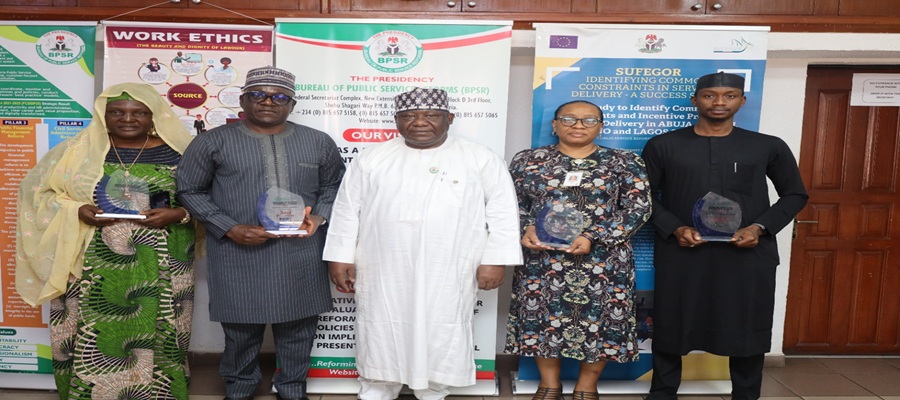Telecom
Fiber Optic Cables and the Coming 5G Revolution

In the near future, Nigeria, like every other country, will require the mass adoption of fifth-generation (5G) technology to get ahead. To achieve this, it will require supporting infrastructure.

Here, we explore why fiber optic cables are a crucial part of this infrastructure, one that Nigerian homes, districts, and cities should acquire.
In recent times, there’s been much talk about 5G technology and the possibilities that it could afford its users. The world anticipates the coming revolution that it will bring: ultra-fast connectivity, a much greater number of connected devices, and support for the Internet of Things (IoT).
Coincidentally, concrete moves towards testing and rolling out 5G across the world have come at the same time with a global spike in the demand for data-hungry services. This event, involving the increased use of video-streaming and video teleconferencing applications, has been driven by the COVID-19 pandemic and the restrictions on physical meetings that have come in its wake.
Nigeria has shown much enthusiasm about 5G. In 2019, it became the first country in Africa to initiate 5G network trials. And in May 2021, its upper legislative house approved the deployment of the technology nationwide.
However, a crucial question remains: do Nigeria’s homes, businesses, districts, and cities possess the infrastructure required for them to make the most of the technology?
5G Network Infrastructure: The Existing Gaps
5G infrastructure consists of a network of large and small cell base stations that possess the edge-computing capabilities needed to make 5G cellular networks functional.
The main infrastructure includes 5G small cell infrastructure and Radio Access Network (RAN) towers. Multiple-input, multiple-output (MIMO) antennas also have to be deployed in large numbers; fiber optic cables play a role as well.
How the Infrastructure Work as a Whole: The service area of 5G networks is divided into cells. Devices in each cell communicate through radio waves with local antennas, transmitters, and receivers. The antennas are connected to transmission electronics, which are in turn connected to switching centers in the telephone network by optical fiber.
Due to the costs involved in building new infrastructure from scratch, 5G is often made to utilize existing structures that have served older generation networks. However, some components may have to be upgraded or replaced for the technology to function as it’s designed to.
One of these components is cabling. In the past, 2G and 3G had relied on copper coaxial cables for carrying telecommunication signals over their networks. The bandwidth demands of 4G meant that they became less desired as a cabling option. They will be unable to support the even higher demands of 5G.
Why Fibre Optic Will Be Important for the 5G Revolution
As has already been hinted at, the major drawback for coaxial cables is the limited speeds that they can support. Until fairly recently, they were adequate for the 3G-dominant telecommunications landscape. But they have since fallen out of favour in quarters seeking faster speeds.
Coaxial cables can achieve speeds of between 10Mbps (Megabytes per second) and 1Gps (Gigabyte per second) and have recorded upload speeds of between 3Mbps and 50Mbps. Optical fiber, on the other hand, can attain speeds exceeding 10Gbps.
A major factor contributing to these differences in speed is the type of transmission carried out by coaxial and fiber optic. While optical fiber transmits signals as light, coaxial moves them in the form of electrical signals. The medium through which they are transmitted plays a role too. Optical fiber is made of glass and plastic; coaxial is primarily made of copper.
When compared to the telephone network generations they are supposed to support, it becomes clear why fiber optic cables are the preferred option for 5G. For instance, 3G devices can connect to the internet at a maximum speed of 21Mbps; 5G speeds can reach 1Gbps.
5G, Fibre Optic, and Last Mile Solutions
Earlier in this article, we referred to the benefits of 5G that homes, districts, and whole regions could access in the near future. Smart buildings, communities, and cities will become a reality, and high-speed connectivity will enable the integration of various economic sectors and drive innovative business models.
As has already been emphasized, the older copper-based transmission lines will not be able to keep up with the data demands of this new reality. Homes already utilizing this older technology may have to upgrade to fiber-optic cables if they are going to enjoy the comforts that 5G will bring.
The smart home will need much faster speeds to make its data-hungry, data-churning environment function optimally. Fiber optic cables could be one of the pillars on which a domestic, fully operational Internet-of-Things (IoT) will rest.
A key strength of fiber optic is that it’s built to last decades, and accommodates an ever-growing demand for data. Even if the much anticipated 5G revolution is slower in coming than expected, current users of fiber optic will find it easier to plug into that revolution when it happens than those without it.
Already, there’s been some movement in the direction of setting up high-speed fiber-optic infrastructure on a city-wide level. In 2020, the government of Lagos began installing fiber optic cables across the city. So far, over 3,000km of fiber optic cables have been deployed, according to the government’s own reports.
As 5G gains traction, it is expected that the provision of fiber optic cables at the level of individual homes will gather pace.
A Fiber to the Home Solution That Works
The advantages of fiber optic are not beyond the reach of Nigerian homes. Like their counterparts elsewhere in the world, they can acquire a Fibre to the Home (FTTH) solution that’s tailored for them.
If you are seeking just such a solution, Layer3 can provide it for you. L3Fiber, our FTTH offering, is designed for homes in Nigeria. It guarantees low latency and ultra-fast connection speeds, allowing you to enjoy world-class internet access.
L3Fiber is also available for estates and can be designed and deployed for communities in cities across the country.
If you would like to learn more about our fiber optic solution, you can contact us here.
Telecom
NCC Ranked Among Top 3 MDAs for Best Website Performance in 2025

Bureau of Public Service Reforms (BPSR) has named the Nigerian Communications Commission (NCC) among the top three Ministries, Departments and Agencies (MDAs) of the Federal Government with the Best Ranking in Website Performance for 2025.

L-R: Head Special Projects, Nigerian Export Promotion Council (NEPC), Salamatu Andu; Executive Commissioner, Technical Services, Nigerian Communication Commission (NCC), Engr. Abaraham Oshadame; Director General Bureau of Public Service Reforms (BPSR), Head Customer Support Service, Galaxy Backbone, Rosemary Ehize; Secretary to the ES. Nigerian Content Development and Monitoring Board, Tahir Aminu at the BPSR award ceremony for top four MDAs in BPSR Website Performance and Ranking 2025 at the BPSR office on Tuesday, 23rd December, 2025.
This is coming barely three weeks after the telecom regulator was recognized as one of the top five best-performing Federal Government agencies for 2025 by the Presidential Enabling Business Environment Council (PEBEC) – a testament to the Commission’s consistency in investment in technology for ensuring efficient service delivery.
In the BPSR 2024/2025 scorecard ranking of agencies’ websites, the NCC came second in the ranking, trailing behind Galaxy Backbone Limited, which came first while the Nigeria Export Promotion Council (NEPC) clinched the third position, from a pool of 235 MDAs, whose website were evaluated.
BPSR deployed 14 evaluation criteria in include MDA’s website compliance with .gov.ng domain name, appearance and aesthetics (look and feel) of the website, content, relevance to MDAs mandate/government policy and the website’ structure.
Others include website’s responsiveness (device compatibility), security, load time, usability/ease of navigation, availability/uptime, functionality, interactivity, accessibility and capacity building.
The recognition was announced at the official release of Federal Government 2024/2025 Scorecard Ranking for MDAs’ Website held at the Federal Ministry of Finance Auditorium in Abuja on Monday (December 22, 2025) while the award presentation took place at BPSR’s Office on Tuesday (December 23, 2025).
The award, which is an important index metric of the National e-Government Masterplan for determining the Nigeria e-Government Status, was received by the Commission in recognition of its commitment to maintaining a world-class website that enhances service delivery to the citizens.
Receiving the award on behalf of the Executive Vice Chairman of the NCC, Dr. Aminu Maida, the NCC’s Executive Commissioner, Technical Services, Abraham Oshadami, appreciated the BPSR for the recognition, describing the award as “another encouragement for the Commission to be a better public service institution leveraging digital platforms such as our web presence to enhance public service delivery to our various stakeholders, thereby implementing the Federal Government’s Ease of Doing Business policy direction.”
While presenting the award to the NCC, alongside other two agencies, BPSR’s Director-General, Mr. Dasuki Arabi, commended the top three for their proactive decisions in maintaining world-class websites, which are compliant with the Federal Government’s policy direction in effective and efficient service delivery to the citizens.
According to the DG, the 2024/2025 MDA’s websites’ ranking represents a collective effort of federal public institutions in Nigeria to be transparent, accountable and open in governance, as well as a confirmation to align with global best practices in service delivery to the citizens.
Developed about six years ago, Arabi said as a result of the annual ranking, more public institutions have indicated readiness to embrace reforms, and align with the policy direction of the current administration’s Renewed Hope agenda on improve governance for effective service delivery, as introduced by His Excellency President Bola Ahmed Tinubu.
“The ideals of harnessing and deploying technological tools for service delivery has become imperative following the COVID pandemic, and distortions of socio-economic system of nations, culminating in the evolution of competitiveness, cost effectiveness, and agile governance.
“As engine room of governance, it behoves on us in the public service to perform our statutory duties and we must put in place technological innovations and standardized websites to operate services as well as deliver service needs to citizens,” he said.
The Scorecard exercise, he said, is part of the BPSR reform broader function of conducting research on reform implementation efforts and presenting ‘best practice’ models to the entire Public Service, and to among others, improve access to government information, facilitate seamless financial transaction, eliminate corruption and cyber theft, as well as facilitate access to government services.
Speaking on the rigorous nature of the exercise that produced the top three winners, the DG said “in the past few weeks members of the Scorecard Jury drawn from inter-Ministerial Agencies, had worked tirelessly to mill websites of selected MDAs through a rigorous process of enduring criteria for the ranking and the outcome had also passed through a quality assurance mechanism to validate the outcome.”
Telecom
Oyedele Dismisses Claims Bank Accounts Without TIN Will Be Frozen

Taiwo Oyedele, Chairman of the Presidential Committee on Fiscal Policy and Tax Reforms, has dismissed reports that bank accounts not linked to a Tax Identification Number (TIN) will be frozen or automatically debited from January 1, 2026.

Taiwo Oyedele
Oyedele described the claims as false and misleading, warning Nigerians against panic over misinformation surrounding recent tax and financial reforms.
In a post on his X handle Tuesday morning, he wrote: “Don’t let anyone manipulate you. Your bank account is safe. Misinformation makes you panic and fear a reform that is designed to help you.
“When they tell you that your account will be frozen or automatically debited from January 2026, ask them for the evidence in the new law. Be wise.”
He stressed that no provision in the new tax laws authorises the freezing of bank accounts, adding that the rumours are part of widespread misrepresentation of the reforms.
The committee chairman reiterated that the reforms are intended to simplify Nigeria’s tax system and ease the burden on ordinary citizens, not to impose punitive measures on bank customers.
Telecom
Amazon Blocks 1,800 North Koreans From Job Applications

US tech giant, Amazon has disclosed that it blocked more than 1,800 North Koreans from applying for jobs, amid growing concerns that Pyongyang is deploying large numbers of IT workers overseas to earn and launder funds.

Amazon
In a LinkedIn post, Amazon’s Chief Security Officer, Stephen Schmidt, said North Korean nationals have been attempting to secure remote IT roles with companies around the world, particularly in the United States.
He noted that the company recorded nearly a one-third increase in such applications over the past year.
According to Schmidt, many of the applicants operate through so-called “laptop farms” — computers physically located in the US but remotely controlled from abroad.
He warned that the issue is not unique to Amazon and is likely occurring at scale across the tech industry.
He added that common red flags include incorrectly formatted phone numbers and questionable academic credentials.
The issue has previously drawn the attention of US authorities. In July, a woman in Arizona was sentenced to more than eight years in prison for running a laptop farm that helped North Korean IT workers obtain remote jobs at more than 300 US companies.
Officials said the scheme generated over $17 million in revenue for both the woman and North Korea.
Last year, South Korea’s intelligence agency also warned that North Korean operatives were using LinkedIn to pose as recruiters, approaching South Koreans working at defence companies in an attempt to steal sensitive technological information.
“North Korea is actively training cyber personnel and infiltrating key locations worldwide,” Hong Min, an analyst at the Korea Institute for National Unification, told AFP.
He added that, given Amazon’s business model, the motivation behind such operations is largely economic, with a high likelihood of attempts to steal financial assets.
North Korea’s cyber warfare programme dates back to at least the mid-1990s and has since expanded into a cyber unit of about 6,000 personnel known as Bureau 121, according to a 2020 US military report.
In November, Washington announced sanctions against eight individuals accused of being state-sponsored hackers, alleging their illicit activities were carried out to fund North Korea’s nuclear weapons programme.
The US Treasury has also accused North Korea-linked cybercriminals of stealing more than $3 billion over the past three years, primarily through cryptocurrency-related crimes.

 News2 days ago
News2 days agoUS Begins Partial Visa Ban on Nigerians January 1

 News2 days ago
News2 days agoDPLAN Threatens NDPC with Legal Action for Setting aside $32.8m Meta Fine

 News2 days ago
News2 days agoGlo Extends Christmas Greetings, Urges Unity and Care for Others

 E-Financial2 days ago
E-Financial2 days agoNOVA Bank Opens Regional Office in Owerri

 E-Financial2 days ago
E-Financial2 days agoNaira Stability, Lower Borrowing Costs Expected in 2026 — CBN Survey

 E-Financial1 day ago
E-Financial1 day agoFIRS says NIN, CAC Numbers to Serve as Tax IDs from 2026

 E-Business2 days ago
E-Business2 days agoGalaxy Backbone Tops FG’s Website Performance Ranking

 General News2 days ago
General News2 days agoBanks warn customers against public Wi-Fi for banking amid festive fraud surge



























